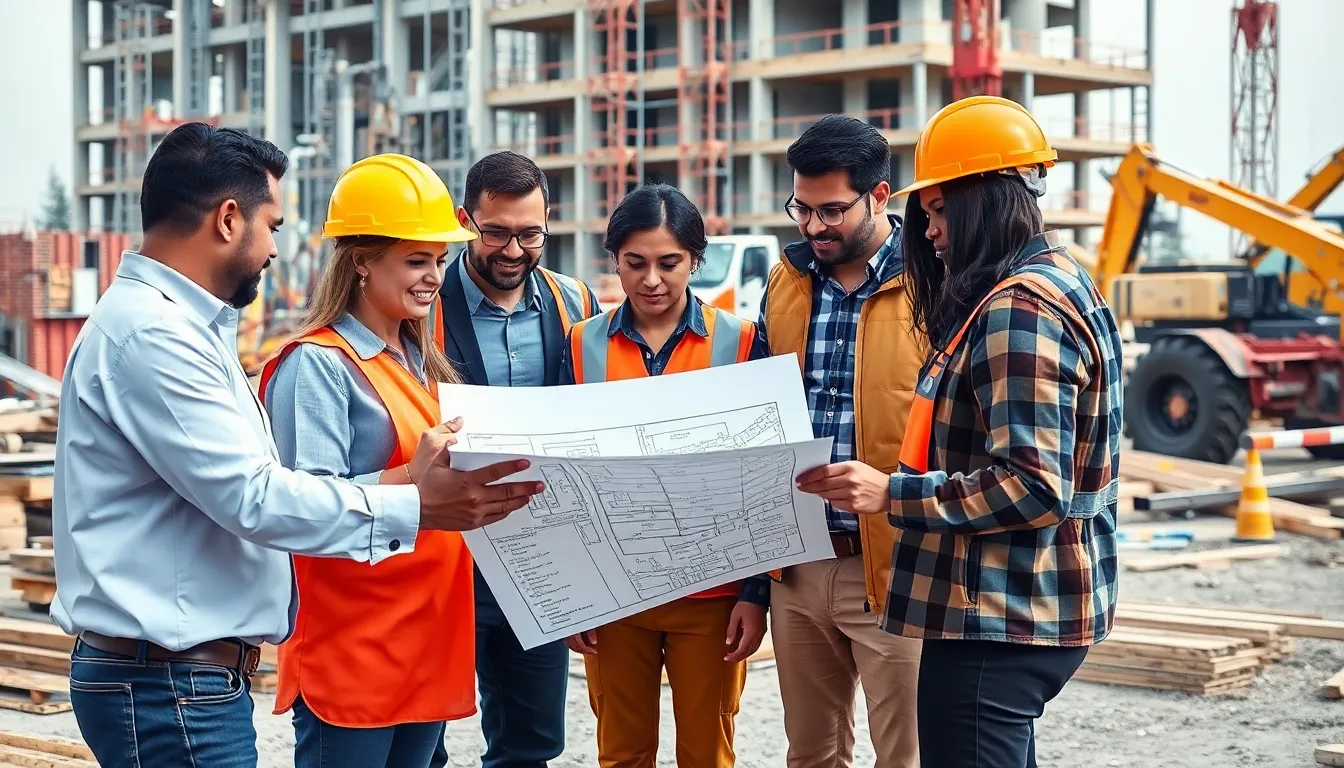In the world of construction, target building is like the secret sauce that turns a simple structure into a masterpiece. It’s not just about bricks and mortar; it’s about crafting spaces that inspire and innovate. Imagine a building that not only stands tall but also stands out, making everyone stop and stare—now that’s a target worth hitting!
Table of Contents
ToggleOverview of Target Building Construction
Target building construction emphasizes creativity and the quality of the spaces created. This approach transforms ordinary structures into architectural masterpieces. It prioritizes the design vision over standard construction processes, leading to innovative and functional environments.
Architects and builders collaborate closely during the project to ensure the final product meets the intended vision. Detailed planning and advanced materials contribute to the overall excellence of target buildings, providing both aesthetic appeal and structural integrity. The process often involves customizing designs to fit specific needs, enhancing the uniqueness of each project.
Budget considerations also play a significant role in target building construction. By allocating resources effectively, projects can achieve a balance between quality and cost. Sustainable practices further modify the construction process, integrating green materials and energy-efficient systems into the designs.
Clients benefit from tailored solutions in target building projects. Feedback mechanisms ensure that the client’s vision aligns with the project’s trajectory, allowing for adjustments as needed. Target buildings often serve as iconic structures within their communities, blending functionality with visual impact.
These projects recognize the importance of modern technology. Tools like Building Information Modeling (BIM) facilitate precise planning and coordination among teams. As a result, target building construction fosters a dynamic relationship between form and function, creating spaces that are not only beautiful but also practical.
Key Components of Target Building Construction

Target building construction relies on several key components to create exceptional structures that stand out. These elements include planning and design, as well as materials selection.
Planning and Design
Effective planning and design serve as the foundation for successful target building projects. Initial stages focus on conceptualizing the space, ensuring alignment with the client’s vision. Architects collaborate closely with builders to fine-tune designs, maximizing aesthetic appeal while prioritizing functionality. Detailed blueprints guide the construction process, enabling accurate execution. Incorporating client feedback throughout ensures that any necessary adjustments are made early, maintaining project coherence. Utilizing modern tools such as Building Information Modeling enhances coordination, allowing for precise tracking of changes throughout the construction lifecycle.
Materials Selection
Choosing the right materials significantly impacts both the visual and structural quality of target buildings. Advanced materials, such as sustainable options, play a pivotal role in meeting modern environmental standards. Selecting materials involves evaluating durability, aesthetics, and cost-effectiveness. Designers often opt for innovative composites to enhance performance while maintaining style. Green building practices also promote the use of energy-efficient materials, contributing to long-term sustainability. The combination of aesthetic preferences and engineering requirements ensures that the final structure resonates with its intended purpose.
Sustainable Practices in Target Building Construction
Sustainable practices play a vital role in target building construction. These approaches enhance environmental responsibility and elevate structural performance.
Energy Efficiency
Energy efficiency remains a top priority in target building construction. Implementing high-performance insulation ensures reduced energy consumption while maintaining comfort. Installing energy-efficient windows further minimizes heat loss, optimizing interior climates. Utilizing solar panels harnesses renewable energy, contributing to lower utility bills. Smart building technologies enable real-time energy monitoring, allowing teams to make informed decisions regarding usage. Designing spaces with natural light reduces reliance on artificial lighting, enhancing occupant well-being. These strategies collectively support sustainability and cost-effectiveness, aligning with modern construction standards.
Waste Reduction
Waste reduction significantly impacts target building construction efficiency. Employing modular construction techniques minimizes material waste and maximizes resource use. Reusing existing structures during renovations decreases the need for new materials, promoting sustainability. Implementing precise prefabrication processes minimizes onsite waste generation. Recycling construction materials not only conserves resources but also reduces landfill impact. Encouraging workforce training around waste segregation promotes responsible disposal practices. These strategies collectively foster a culture of sustainability within target building projects, benefiting both the environment and the project budget.
Challenges in Target Building Construction
Target building construction presents various challenges that can impact project success. Effective communication among all parties is vital, as misinterpretations between architects and builders can lead to significant delays. Unforeseen site conditions also pose risks, including geological surprises that complicate construction processes and increase costs.
Budget constraints represent another obstacle. Allocating funds appropriately while still adhering to quality standards demands careful planning and execution. Many projects face this challenge, particularly when unexpected expenses arise, forcing teams to revisit their financial strategies.
Material selection can complicate the construction timeline. Finding advanced, sustainable materials that align with both aesthetic and structural requirements often requires extensive research. Additionally, sourcing these materials might lead to delays, especially if they are not readily available.
Regulatory compliance frequently adds another layer of complexity. Navigating local building codes and zoning laws requires thorough understanding and adaptability to avoid legal issues that can stall progress. Permitting processes can take longer than anticipated, consequently impacting project schedules.
Environmental considerations cannot be overlooked. Implementing sustainable practices often leads to increased initial costs, though long-term benefits typically justify this investment. Implementing energy-efficient strategies may involve additional planning and resources, creating potential hurdles during the construction phase.
Technology integration has become a double-edged sword in target building construction. While tools like Building Information Modeling (BIM) enhance precision and coordination, adapting to new technologies requires training and often an upfront investment. Each challenge necessitates comprehensive planning and a commitment to collaboration to achieve desired outcomes in target building projects.
Innovations in Target Building Construction
Target building construction embraces numerous innovations that elevate both design and functionality. Advanced materials play a significant role in this evolution, offering durability and aesthetic appeal. Architects increasingly utilize smart materials that respond to environmental changes, enhancing energy efficiency and occupant comfort.
Building Information Modeling (BIM) has transformed the planning and coordination processes. This technology allows for precise visualizations and simulations, reducing errors and facilitating collaboration among teams. Enhanced communication through BIM minimizes misunderstandings, streamlining the construction workflow.
Sustainable practices are central to innovations in this field. Energy-efficient systems, like solar panels and high-performance insulation, not only contribute to environmental goals but also reduce long-term operational costs. Implementing green roofs and water management systems further promotes ecological responsibility while creating attractive spaces.
Modular construction techniques are gaining traction as well. These methods enable quicker assembly and reduced waste, aligning with sustainability goals. Prefabricated components let teams focus on creating quality designs while minimizing on-site disruptions.
Smart technology integration reshapes how buildings respond to occupant needs. Automated lighting, heating, and security systems enhance convenience and safety. As these technologies evolve, target buildings become more adaptable and user-friendly.
The incorporation of augmented reality (AR) and virtual reality (VR) is also noteworthy. These technologies allow stakeholders to engage with design concepts actively, fostering better client relationships. By enabling clients to visualize spaces before construction begins, AR and VR help secure alignment with their visions.
Emphasizing innovation, target building construction reflects a commitment to creativity, sustainability, and advanced technology. Each of these elements combines to produce not only structures but also high-quality experiences for occupants, setting new standards in the industry.
Target building construction represents a significant evolution in the architectural landscape. By prioritizing creativity and sustainability, it transforms ordinary structures into remarkable landmarks. The collaboration between architects and builders ensures that each project aligns with a clear vision while embracing advanced materials and innovative technologies.
As the industry moves forward, the emphasis on energy efficiency and environmental responsibility will continue to shape the future of construction. Overcoming challenges through effective communication and thorough planning is essential for success. Ultimately, target building construction not only enhances aesthetic appeal but also contributes to the overall well-being of communities, setting a new benchmark for excellence in the field.







